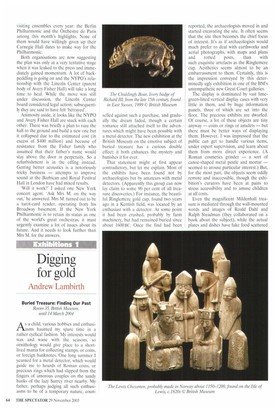Digging for gold
Andrew Lambirth
Buried Treasure: Finding Our Past Room 35, British Museum, until 14 March 2004
Asa a child, various hobbies and entbusisms haunted my spare time in a rather cyclical fashion. My interests would wax and wane with the seasons, so ornithology would give place to a shortlived mania for collecting stamps, or coins, or foreign banknotes. One long summer I yearned for a metal detector, which would guide me to hoards of Roman coins, or precious rings which had slipped from the fingers of amorous couples on the sandy banks of the lazy Surrey river nearby. My father, perhaps judging all such enthusiasms to be of a temporary nature, coun
selled against such a purchase, and gradually the dream faded, though a certain romance still attached itself to the adventures which might have been possible with a metal detector. The new exhibition at the British Museum on the emotive subject of buried treasure has a curious double effect: it both enhances the mystery and banishes it for ever.
That statement might at first appear contradictory, but let me explain. Most of the exhibits have been found not by archaeologists but by amateurs with metal detectors. (Apparently this group can now lay claim to some 90 per cent of all treasure discoveries.) For instance, the beautiful Ringlemere gold cup, found two years ago in a Kentish field, was located by an enthusiast with a detector. At some point it had been crushed, probably by farm machinery, but had remained buried since about 1600 BC. Once the find had been
reported, the archaeologists moved in and started excavating the site. It often seems that the site then becomes the chief focus of interest. It's as if archaeologists would much prefer to deal with earthworks and aerial photographs, with maps and plans
and rotted posts, than with such exquisite artefacts as the Ringlemere cup. Aesthetics seems almost to be an embarrassment to them. Certainly, this is the impression conveyed by this determinedly ugly exhibition in one of the BM's unsympathetic new Great Court galleries.
The display is dominated by vast limegreen-lined vertical display cases with very little in them, and by huge information panels, three of which are set into the floor. The precious exhibits are dwarfed. Of course, a lot of these objects are tiny anyway — coins or rings or amulets — but there must be better ways of displaying them. However, I was impressed that the public can get to handle various items, under expert supervision, and learn about them from more direct experience. (A Roman cosmetics grinder — a sort of canoe-shaped metal pestle and mortar — seemed to arouse particular interest.) But, for the most part, the objects seem oddly remote and inaccessible, though the exhibition's curators have been at pains to stress accessibility and to amuse children at all costs.
Even the magnificent Mildenhall treasure is mediated through the wall-mounted words and images of Roald Dahl and Ralph Steadman (they collaborated on a book about the subject), while the actual plates and dishes have fake food scattered
over them so that we can no longer see their intricate designs. Is this supposed to make them more real, or instruct lamebrains of their purpose? Much more telling is the information that the treasure's finder, Sidney Ford, who quite understandably wanted to keep it for himself, and did so for several years, used the Great Dish for fruit at Christmas. Perfect! What better use for it? The fact that it is an exceptionally fine example of Roman silver tableware of the 4th century AD only adds poignancy to the story.
There are other fine things to be seen, from a fascinating collection of intaglios and memorial and mourning rings (Charles I seemed a popular subject) to the less valuable but often equally elaborate pilgrim badges. Although the rest of the objects come from England and Wales, the famous Lewis Chessmen are included, partly, I suspect, because they featured in the first Harty Potter film. These dour little figures, carved from walrus ivory or whale's teeth in the 12th century, were found on the Isle of Lewis in Scotland in the 1820s. Far more numinous and ornate is the Iron Age Celtic Battersea Shield, dating from c. 350-50 BC, and found in the Thames in 1857. A case of golden torcs from Snettisham in Norfolk is mildly exciting. I much preferred the slightly creepy silver-gilt Buntingford figurine, supposedly of a saint or other biblical character, and a Delftware dish depicting Charles II hiding in an oak tree. Historically mind-boggling was the handaxe also found in Norfolk, and now tentatively dated to between 500,000 and 700,000 years ago. If correctly dated, this would suggest that Britain had been inhabited much longer than previously thought. But perhaps here we enter the realm of conjecture.
When I discovered that Buried Treasure is the first archaeology exhibition at the BM in almost 20 years, it was difficult to know whether to laugh or cry or simply be grateful. Is there no way that archaeological exhibition design standards can be improved and presentation made more adult? Why does archaeology voluntarily give itself such a bad name? This exhibition is gruesome. Even the jargon is hideous.
I'm rather glad my father dissuaded me from acquiring a metal detector all those years ago. I might have ended up wearing an anorak anxiously in pursuit of the next 'findspot', determined to beat my fellow 'metal detectorists' to the pot of gold at the end of the neolithic rainbow. Not that it's the gold that glitters — only the 'findspot'. If you take the art out of artefacts, you are left with the facts, and I have a sneaking suspicion that's the way archaeologists like it best. Luckily, however hard people try to disguise it, the romance and beauty remains yet in the objects themselves. Only the context repels.



























































































 Previous page
Previous page